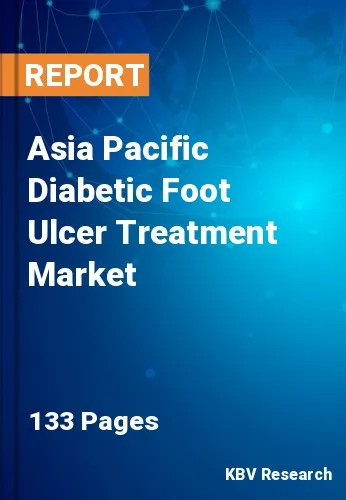
The Asia Pacific Diabetic Foot Ulcer Treatment Market would witness market growth of 5.9% CAGR during the forecast period (2023-2030).
The most typical complication of diabetes is diabetic foot ulcers, which may have severe consequences if not adequately managed and treated. Multiple variables, including peripheral neuropathy, peripheral vascular disease, and delayed wound healing brought on by diabetes, contribute to their occurrence. Untreated diabetic foot ulcers may cause infection, tissue damage, and, in severe cases, amputation. They often widen towards the bottom of the feet. Treatment for diabetic foot ulcers aims to enhance wound healing, stave off infection, and lessen the likelihood of complications.
The rise in the geriatric population, rise in diabetes incidence, and rise in technical improvements in wound care management products are the main drivers of the market. Diabetes incidence is increasing regionally and is a key market driver.
According to the most current statistics, 8.6% of India's population, or 104 million individuals, are 60 or older. Males outweigh females among seniors (60+). The National Policy on Older Persons (1999), the Maintenance and Welfare of Parents and Senior Citizens Act (2007), and the National Policy for Senior Citizens (2011) of the Government of India give the framework within which to address the requirements of seniors. Elderly patients get specialized treatment in primary healthcare via the National Programme for Health treatment of the Elderly and Health and Wellness Centers under the Ayushman Bharat initiative.
The average life expectancy was 87.32 years for women and 81.25 years for males as of 2018. By 2065, the average life expectancy for men and women is anticipated to be 84.95 and 91.35 years, respectively. The proportion of individuals over 65 (the old) has also been rising and is now one of the highest in the world. In 2019, it was 28.4%; by 2036, it should be 33.3%; and by 2065, it should be 38.4%. The risk of diabetes and diabetic foot ulcers is predicted to increase dramatically with an older population, creating growth opportunities in the local market.
The China market dominated the Asia Pacific Diabetic Foot Ulcer Treatment Market by Country in 2022, and would continue to be a dominant market till 2030; thereby, achieving a market value of $481 million by 2030. The Japan market is registering a CAGR of 5.3% during (2023 - 2030). Additionally, The India market would showcase a CAGR of 6.6% during (2023 - 2030).
Based on Product, the market is segmented into Wound Care Dressings, Wound Care Devices (Negative Pressure Wound Therapy, and Others), Biologics, and Others. Based on Type, the market is segmented into Neuroischemic Ulcers, Neuropathic Ulcers, and Ischemic Ulcers. Based on End User, the market is segmented into Homecare Settings, Hospitals, and Others. Based on countries, the market is segmented into China, Japan, India, South Korea, Singapore, Malaysia, and Rest of Asia Pacific.
Free Valuable Insights: The Worldwide Diabetic Foot Ulcer Treatment Market is Projected to reach USD 6.5 Billion by 2030, at a CAGR of 5.2%
The market research report covers the analysis of key stake holders of the market. Key companies profiled in the report include Coloplast Group, B. Braun Melsungen AG, Integra LifeSciences Holdings Corporation, Smith & Nephew PLC, Cardinal Health, Inc., Medtronic PLC, 3M Company, Molnlycke Health Care AB, Essity AB and ConvaTec Group PLC.
By Product
By Type
By End User
By Country
Our team of dedicated experts can provide you with attractive expansion opportunities for your business.
